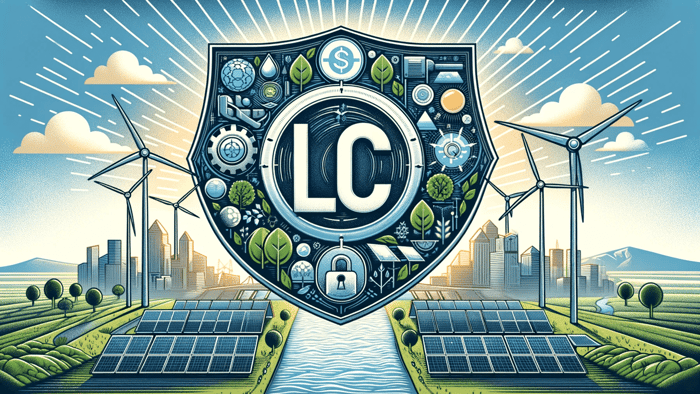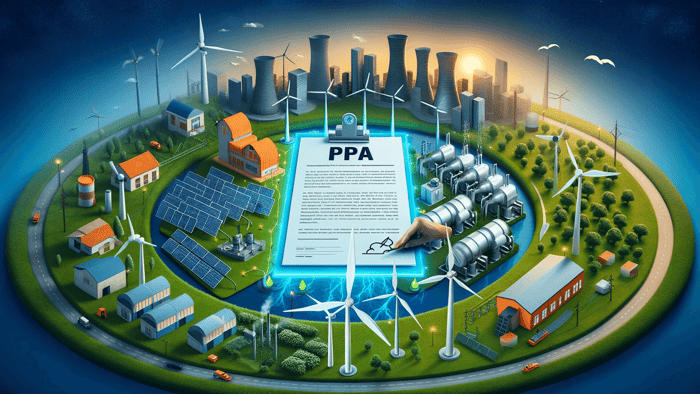A Letter of Credit (LoC) is a financial commitment issued by a bank on behalf of its client, guaranteeing payment to a seller under specified conditions. Serving as a cornerstone of global trade, it ensures that transactions are executed securely and efficiently, bridging trust between parties across borders.
What is a Letter of Credit (LoC)?
A Letter of Credit (LoC) is essentially a financial safety net, provided by a banking institution, that underwrites a guarantee within a transaction. This guarantee can vary, often covering payment obligations, but it can also extend to the assurance of project completion. Such a mechanism is indispensable in project finance, particularly within the renewable energy sector, where the scale and complexity of projects necessitate robust financial security measures.
In the context of renewable energy projects, the relationships between parties—ranging from project sponsors to suppliers—can be marked by uncertainty due to the limited direct interactions and the complex nature of these projects. To bridge this trust gap, a project sponsor might leverage its relationship with its primary bank, requesting the issuance of an LoC in its favor. This acts as a pledge to the counterparty that the project's financial obligations will be met, or certain project milestones achieved, under the bank's guarantee.
The issuance of a Letter of Credit provides reassurance to all parties involved. It signifies that the bank vouches for the respective counterparties’ reliability, substituting the counterparties’ creditworthiness (which might be difficult for others to evaluate directly) with the bank's reputable standing. For a fee, this arrangement not only secures transactions against the backdrop of international trade's inherent risks—such as political instability, logistical challenges, and regulatory hurdles—but also specifically addresses the unique risks associated with financing renewable energy projects, including project completion risks and long-term payment commitments.
Employed frequently in international dealings, Letters of Credit are essential in smoothing over the potential frictions caused by cross-border trust issues, timing mismatches, and the heightened risks of dealing with new or diverse regulatory environments. In the context of renewable energy, where involved contractual counterparties often span countries and continents, LoCs play a crucial role in ensuring that these green initiative projects advance towards realization, backed by solid financial guarantees.
📽️ Watch: How to Model Letters of Credit in Project Finance
Want to see how Letters of Credit are modeled in a real financial model? Watch this expert-led tutorial from our Expert-Level Project Finance Modeling for Renewable Energy course:
Key Takeaways: Letters of Credit in Renewable Energy Project Finance
- Financial Safety Net: LoCs act as guarantees from banks on behalf of their clients, ensuring payment or project completion under specific conditions.
- Global Trade Cornerstone: They secure and streamline international transactions, building trust across borders.
- Project Finance Essential: Especially vital in renewable energy sectors, where projects' complexity and scale require robust financial guarantees.
- Bridging Trust Gaps: Facilitate cooperation between project sponsors and suppliers, overcoming uncertainties due to limited interactions and complex project demands.
- Bank's Guarantee: Offers reassurance by substituting the bank's creditworthiness for the counterparties’, ensuring financial obligations are met.
- Mitigating Risks: Protects against international trade risks, including political, logistical, and regulatory challenges, specifically catering to renewable energy project needs.
- International and Cross-Border Projects: LoCs are crucial for managing the intricacies of renewable energy projects that span multiple jurisdictions, ensuring progress and fulfillment of green initiatives.
Types of Letters of Credit in Renewable Energy Project Finance
Letters of Credit (LoCs) are essential instruments in the financing of renewable energy projects, providing a secure foundation for transactions between parties often separated by vast distances and differing legal systems. These instruments can be broadly categorized into two main types: Financial Letters of Credit and Documentary (or Standby) Letters of Credit. Each serves a unique function in the context of trade finance, with specific implications for the renewable energy sector.
1. Financial Letter of Credit
Financial LoCs function similarly to a certified cheque in the banking sector, offering a guarantee of payment upon fulfillment of agreed terms, such as the presentation of a bill of lading to signify the shipment of goods. This type of LoC acts directly as a method of payment and is typically utilized in transactions where immediate financial settlement is required upon the completion of specific conditions. For renewable energy projects, Financial LoCs are crucial in ensuring timely payment to suppliers and contractors, thereby facilitating smooth project progression and helping to maintain strict project timelines.
2. Documentary (or Standby) Letter of Credit
Documentary or Standby LoCs, while also guarantees of payment, are not intended to be called upon under normal transaction conditions. The need to draw upon a Standby LoC indicates a deviation from the agreed terms, such as a failure to meet contractual obligations. These LoCs serve as a safety net, providing financial assurance that compensates for non-performance or breaches of contract. In the context of renewable energy, Standby LoCs are especially important as they offer a layer of security that can help manage the complex risks associated with large-scale, long-term projects, covering everything from construction milestones to long-term operational commitments.
In a typical transaction involving LoCs, the buyer (Applicant) requests their bank (the Issuing Bank) to issue a Letter of Credit in favor of the seller (Beneficiary). This process involves not just the buyer and seller but also their respective banks, serving as the Advising Bank for the seller and the Issuing Bank for the buyer. The Advising Bank acts as an intermediary, ensuring the terms of the LoC are met before facilitating payment.
For renewable energy projects, the choice between a Financial and a Documentary LoC depends on the specific needs and risks of the project. Financial LoCs might be more relevant in transactions requiring straightforward, immediate payments upon delivery of goods or services. Meanwhile, Documentary or Standby LoCs are indispensable for projects that entail complex, phased deliveries, or where there is a significant emphasis on performance guarantees over time.
How a Standby Letter of Credit Works for a Module Supply Agreement (MSA)
In renewable energy project finance, a Standby Letter of Credit (Standby LC) is an indispensable safeguard, ensuring that financial commitments are honored even when unexpected circumstances disrupt the contractual obligations. It is critical for agreements like Module Supply Agreements (MSA) or Turbine Supply Agreements (TSA), where the procurement and installation of solar panels, wind turbines, or other renewable equipment are involved.
A Standby LC provides the beneficiary (the supplier in an MSA) with confidence that they will receive payment if the project sponsor (the applicant) does not adhere to the specific terms outlined in the MSA. This might include situations where the project sponsor fails to pay upon successful delivery and installation of modules, or does not meet pre-agreed project milestones or quality standards.
In renewable energy projects, significant upfront investment is commonplace. Suppliers seeking assurances against default by the project sponsor can rely on a Standby LC as a financial guarantor. In securing a Standby LC, the project sponsor often provides a PCG or cash collateral to the issuing bank, which offers further credit support and ensures immediate availability of funds should the LC be drawn upon.

The process typically includes these steps:
1. Agreement on Terms: The project sponsor and module supplier outline the MSA terms, detailing payment schedules, delivery milestones, and quality metrics.
2. Issuance of Standby Letter of Credit: To provide the supplier with assurances, the project sponsor arranges for their bank to issue a Standby LC, covering a significant contract value as a financial safety net for the supplier.
3. Role of Banks: The supplier's bank (Advising Bank) holds the Standby LC and, in the event of a contractual breach, demands payment from the Issuing Bank as per the Standby LC terms.
4. Collateral Requirements: The Standby LC typically requires the project sponsor to post a PCG or cash collateral, guaranteeing fund availability for immediate payment if the LC is activated.
Standby Letters of Credit thus serve as a cornerstone in renewable energy project finance, facilitating trust, and reducing risk. They ensure that suppliers are comfortable providing high-quality, essential equipment and services, thereby contributing to the success and sustainability of renewable energy projects.
Understanding PPA Letters of Credit in Renewable Energy Financing
A Power Purchase Agreement (PPA) is a contract between an energy seller and a purchaser, often used in the renewable energy sector. In such agreements, the stability and predictability of payments are essential. A PPA Letter of Credit (PPA LC) is a financial tool that ensures the energy seller receives timely payments under the terms of the PPA. This kind of LC is particularly important in renewable energy projects where long-term contracts for power supply are common, and the financial stability of the seller must be secured to maintain project viability.
Here’s how a PPA LC typically operates:
1. Initiation of the PPA: An energy producer (the seller) enters into a PPA with a purchaser (the off-taker), agreeing to supply a certain amount of electricity at a predetermined price over an extended period. This contract is essential for ensuring the economic feasibility of the renewable energy project.
2. Requirement for an LC: To secure the PPA, the purchaser may be required to provide a Letter of Credit, particularly if there's a perceived credit risk or to meet regulatory requirements. This guarantees that the seller will receive payment for the electricity supplied, even if the purchaser defaults.
3. Issuance of the PPA LC: The purchaser approaches their financial institution to issue an LC in favor of the seller. The amount of the LC is typically tied to the projected cost of electricity for a set period, such as several months.
4. Role of the Issuing and Advising Banks: As with Standby LCs, the purchaser's bank becomes the Issuing Bank, while the seller may have an Advising Bank to manage the receipt and potential calling of the LC.
5. Drawing on the LC: If the purchaser fails to make payment as per the PPA terms, the seller has the right to draw on the LC up to the covered amount. The Issuing Bank is then obligated to pay the seller, ensuring that the financial risk of non-payment is mitigated.
6. Renewal of the LC: PPA LCs are often valid for the term of the power purchase agreement or a significant portion thereof, with provisions for renewal to ensure continuous coverage.
7. Collateral and Fees: The purchaser generally provides collateral to their bank to back the LC, which could be cash or other liquid assets. Fees for issuing and maintaining the LC are also common, reflecting the cost of this financial guarantee.
In the renewable energy sector, PPA LCs are critical for managing payment risk over the long term. They give confidence to energy producers that they will receive their due payments, enabling them to secure financing for the project, maintain operations, and plan for future expansion.
The Role of Decommissioning Letters of Credit in Renewable Energy
In the lifecycle of a renewable energy project, the end-of-life phase, or decommissioning, is a crucial consideration. A Decommissioning Letter of Credit (Decommissioning LC) is a financial tool designed to ensure that there are sufficient funds available to safely decommission a renewable energy installation, such as a wind farm or solar park, and restore the site at the conclusion of its productive life. This type of LC is particularly critical in addressing environmental concerns and adhering to regulatory obligations.
Here’s how a Decommissioning LC typically functions:
1. Project Planning and Approval: During the planning and regulatory approval stages of a renewable energy project, operators are often required to demonstrate financial capability to cover future decommissioning costs. This is to assure that the site can be returned to its original state or repurposed without imposing a financial burden on the community or the government.
2. Setting Aside Funds: Instead of setting aside a large sum of cash for decommissioning—which could be decades away—an operator can secure a Decommissioning LC. This LC acts as a proof of secured funds that will be available when decommissioning becomes necessary.
3. Issuance of the LC: The operator requests a financial institution to issue a Decommissioning LC for the estimated cost of decommissioning. The issuing bank evaluates the request based on the project’s risk, the operator’s creditworthiness, and the estimated decommissioning costs.
4. Financial Assurance to Regulatory Bodies: The Decommissioning LC is often submitted to regulatory bodies as part of the compliance requirements, ensuring that the funds for decommissioning are guaranteed by a credible financial institution.
5. Maintenance and Review: The Decommissioning LC is typically maintained for the life of the project. It may be subject to periodic review and adjustments based on changes in decommissioning cost estimates, regulatory requirements, or the financial condition of the operator.
6. Activation of the LC: Should the operator fail to decommission the project as required, or if the operator goes bankrupt, the regulatory body or another authorized entity can draw on the Decommissioning LC to access the funds needed for decommissioning.
7. Collateral and Fees: The operator usually provides collateral to the issuing bank to back the Decommissioning LC, ensuring that the bank has security against the potential future liability. Additionally, fees for issuing and servicing the LC are common.
By employing a Decommissioning LC, renewable energy project operators can responsibly manage end-of-life obligations without tying up capital resources that could be used for operational or expansion purposes. This approach not only satisfies regulatory decommissioning fund requirements but also instills confidence in stakeholders that environmental remediation will be adequately financed.
LoCs: The Financial Protectors of Renewable Energy Projects
In essence, Letters of Credit (LoCs) act as the financial protectors in the renewable energy sector, ensuring secure and trusted project financing. These instruments are critical for managing payments to suppliers via Module Supply Agreements and stabilizing long-term revenue streams through PPA LoCs, establishing a reliable financial foundation for energy projects.
Their influence extends to ensuring responsible decommissioning, with Decommissioning LoCs earmarked for site rehabilitation, underscoring the industry’s dedication to environmental and fiscal prudence.
As renewable energy continues to advance, the strategic employment of LoCs will remain integral to promoting sustainable development. These financial tools are not merely transactional instruments but are pivotal in supporting the industry’s trajectory towards a sustainable and energy-efficient tomorrow.






